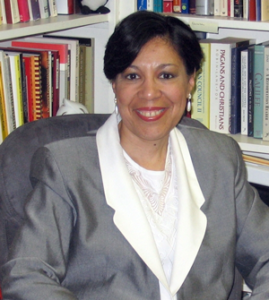anti-racism
Select an item by clicking its checkbox
When those of the dominant culture express shock and dismay at events such as those that took place in Ferguson, Missouri in 2014, when they claim with indignation that this “should never happen again,” I think of a Puerto Rican proverb: “No hay peor ciego que el que no quiera ver (...
I admit that I was a bit flumoxed by how disoriented most of the students in my class were through much of the semester. My two very talented TAs were likewise lost for an answer. We realized late in the game that the reason for this seeming disorientation was there ...
When I signed up to teach the Bible and Race in the USA, I didn’t know that my students would be able to live stream the lynching of Eric Garner and Tamir Rice. No one told me that modern courtrooms would accept a testimony from one who could liken ...
In some ways it’s really simple. If we had genuinely multi-racial classrooms in the U.S. the challenge of race in those same rooms would be much less of one. We so quickly find ourselves embroiled in an oh-so-familiar conversation when the pedagogical question becomes how to best teach ...

Muslim Women, Transnational Feminism and the Ethics of Pedagogy: Contested Imaginaries in Post-9/11 Cultural Practice
Date Reviewed: February 12, 2015
Speaking about her identity as a Muslim woman, spoken-word poet Sofia Baig said, “At a certain point, you have to raise your voice and fight to take it back” (275). In that spirit, this volume unites reflection and action for transformational pedagogy. By teaching readers to recognize negative stereotypes about Muslim women and exposing complicity with imperialism in some uncritical forms of multiculturalism, these essays make a significant contribution to social justice education. Collectively these authors model the transnational feminist praxis they propose. The volume offers a treasury of references to Muslim women artists as well as caution about the ways that some authentic voices have been commodified and co-opted. Interviews with artists expand and enrich the scholarly examination of pedagogical questions regarding authority, agency, representation, and identity.
Contributors present an impressive array of arguments that problematize pervasive errors in “liberal” or “Western” feminism because it has contributed to simplistic and oppressive images of Muslim women in ways that feed the justification for violence, war, and imperialism. For example, Megan MacDonald effectively demonstrates how glib ideals of the “universality of global sisterhood” can be co-opted to justify “the occupation’s military industrial agenda” if Muslim women are reduced to oppressed victims in need of rescue (39). Similarly, Catherine Burwell warns about exploitive trends in marketing and uncritical reading of fiction featured by North American women’s book clubs that sometimes perpetuate those negative images. Over and over, these writers examine the dangers of depoliticizing and disconnecting women’s voices from historical context. At the same time, these scholars call for art and critical education in both public and academic settings that broadens and deepens antiracist, anticolonial, transnational feminist cultural production. For instance, the creation of the “Hijabi Monologues,” by Sahar Ishtiaque Ullah actively counters the “conflation of Middle East and Arab and Muslim” (286). Readers get a glimpse of what Mehre Gomez Fonseca calls “pedagogical means to unlearn Arabphobia and Islamaphobia” (198).
These artists, scholars, and educators warn readers against unethical use of some literature written by Muslim women that is quite well known. At the same time, they introduce readers to new artists whose work may be less familiar. Full transcripts of interviews with Muslim women artists include: conversations with novelist Mohja Kahf, documentary filmmaker and writer Zarqa Nawaz, curator and writer Rasha Salti, editor and publisher Tayyibah Taylor, spoken-word poet Sofia Baig, theater director and writer Sahar Ullah, and visual artist Jamelie Hassan.
Social justice educators committed to antiracism, anticolonialism, and transnational feminism will appreciate this corrective to mistakes that many of us have unwittingly made. Readers find suggestions for anticolonial praxis such as “ethical practices for reading across difference” examining privilege and power, and opening up “space of dialogue, debate, and dissent” (195). The book will be of particular interest to those who teach religious studies, feminist studies, and multicultural literature.



